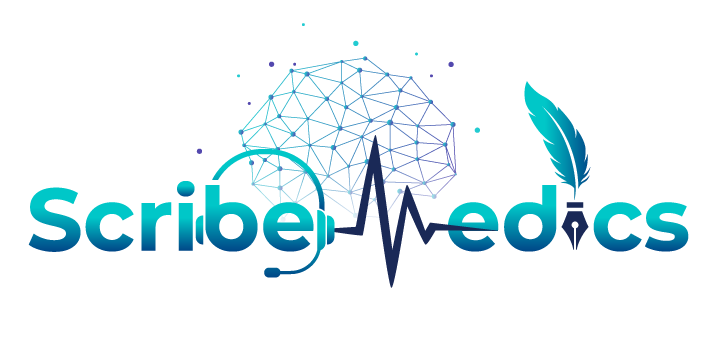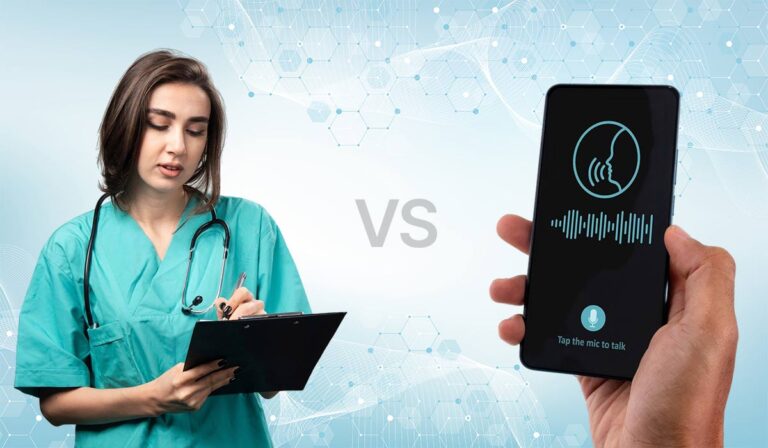Imagine a world where medical practitioners are able to devote more of their time to the patients and less time buried in paperwork. What if administrative tasks like medical transcription didn’t consume valuable clinical hours? In a healthcare environment where every minute counts, medical transcription services like those offered by ScribeMedics are the key to improving clinical efficiency, reducing medical errors, and giving doctors more time to focus on patient care.
Medical transcription refers to the practice of taking audio recordings made by medical professionals and turning them into accurate written medical records. These written records consist of vital information such as patient history, treatment strategies, and the use of medical terminology, all of which are indispensable for providing patients with the right care. By relying on medical transcriptionists and modern transcription tools, healthcare facilities can streamline the documentation process, save valuable time, and reduce errors that could compromise patient safety.
This blog explores the ways through which the medical transcription services not only bring advancements to the clinical efficiency but also lead to the reduction of errors in patient care, improvement of the documentation process, and improvement of the overall quality of care in healthcare facilities across the United States of America.
The Growing Need for Medical Transcription in Healthcare
The significance of accurate medical records is something that cannot be emphasized enough. The increasing need for high-quality patient care across the USA and other countries has made healthcare facilities rely more on medical transcription services to maintain the precision of their patient data. This has turned out to be a very important tool in improving clinical efficiency and reducing errors.
In an atmosphere where administrative tasks usually take away the time meant for direct patient care, medical transcription services are a solution that allows health care workers to spend more time with their patients and less time on paperwork. By leveraging professional medical transcriptionists, healthcare organizations are ensuring that patient records are handled with the highest level of accuracy and precision. In the United States of America, leading providers like ScribeMedics help healthcare facilities streamline documentation, save time, and minimize risks of patient record errors.
How Medical Transcription Improves Clinical Efficiency
Clinical efficiency improvement with medical transcription can be achieved in several ways. Here’s how medical transcription services help reduce the time spent on documentation and improve the overall patient care process.
1. Faster Turnaround Times
The enhancement of turnaround times for patient records is one of the strikingly noticeable advantages provided by medical transcription services. Doctors can dictate notes on patient histories, treatment plans, and diagnostic information, which are then quickly transcribed by medical transcriptionists. This speedy documentation process helps ensure that patient information is readily available for quick decision-making, enabling healthcare providers to make more timely and informed decisions. This contributes directly to improving clinical efficiency with medical transcription.
2. Improved Patient Care through Accurate and Timely Documentation
With the aid of medical transcription services, health care providers can ensure that all patient information is accurately documented and available in real time. This results in a better documentation process but also enhances the quality of patient care. By having accurate, up-to-date patient records at their disposal, healthcare professionals can offer more personalized and effective treatment plans.
For example, a medical transcriptionist may record exactly what a doctor has described in his/her consult of the patient’s symptoms, diagnosis, and treatment. That way, when the next healthcare professional comes to review that record, they can see a full history of what their visit entailed and are able to make informed decisions about the next steps of the treatment plans.
3. Reduction of Physician Burnout
Physician burnout is already a major issue in the USA and even in other countries. Among the administrative tasks that each physician has to deal with, medical documentation takes a large part of their day. Such a scenario results in long working hours, high levels of stress, and finally, burnout. On the other hand, if the transcription services are outsourced, physicians who work in the hospitals that have been using the services will no longer have to worry about documentation and will devote their time to caring for patients, which is the essential part of the whole process.
Moreover, when the healthcare professionals do not have to take care of the patient record’s detailed transcription, the levels of their stress are drastically lower, and job satisfaction is much higher. This, in turn, leads to clinical efficiency improvement by ensuring that healthcare professionals remain engaged and energized throughout their workday.
4. Improved Accuracy of Patient Records
One of the main objectives of medical transcription services is to help maintain the patient records’ accuracy, timeliness, and compliance with the industry standards. Accurate patient records are a prerequisite for safe and effective treatment and patient safety. When healthcare providers dictate their notes, medical transcriptionists transcribe the information with precision, ensuring that medical histories, diagnoses, treatment plans, and medications are recorded correctly.
This accuracy level is vital for the minimization of medical error risk, which sometimes arises due to the lack of proper, timely, or correctly documented patient information. Medical transcription services play a crucial role in reducing errors with medical transcription, ensuring that patient records are comprehensive, accurate, and ready for use at any time.
5. Cost-Effective Solution for Healthcare Organizations
For many healthcare organizations, maintaining an in-house transcription department is costly and resource-intensive. Medical transcription outsourcing, on the other hand, serves as a cost-cutting solution, making it possible for healthcare organizations to have access to skilled transcriptionists without the need for hiring and managing full-time staff. By outsourcing transcription tasks, healthcare organizations can save money on office space, equipment, salaries, and training.
In this way, smaller practices and clinics can afford high-quality transcription services, which would eventually lead to overall clinical efficiency improvement. Moreover, outsourcing provides scalability, allowing healthcare organizations to adjust the level of transcription services based on patient volume without incurring additional overhead.
6. Improving Workflow Automation
The use of medical transcription services in electronic health record (EHR) systems is a significant advantage that these services have to offer in terms of clinical efficiency. By utilizing medical transcription software that is compatible with EHRs, healthcare professionals can ensure that patient information is entered into the system seamlessly. This workflow automation improves the speed at which patient records are updated, ensuring that all information is current and available when needed. As a result, healthcare organizations can experience clinical efficiency improvement with medical transcription, reducing delays and improving the flow of information across departments.
How Medical Transcription Services Reduce Errors in Patient Care
One of the major problems in the health care industry across the USA is medical errors, and many such errors are a result of inaccurate or incomplete patient records. Medical transcription services play a critical role in minimizing these errors by ensuring that patient information is accurately documented and updated in real time.
Here’s how medical transcription services reduce errors and promote patient care by ensuring greater accuracy and thoroughness in patient records.
1. Ensuring Comprehensive Patient Histories
Thorough medical histories are critical for diagnosis and treatment. Medical transcriptionists make sure that every detail of a patient’s history is done properly. This includes past treatments, allergies, current medication, and other factors necessary for treatment. By capturing a thorough patient history, medical transcription services enable healthcare professionals to make better-informed decisions.
A doctor, for example, can record very thorough notes about the medical treatment a patient with a chronic disease is undergoing. All the notes are transcribed by the medical transcriptionists to capture all the important aspects precisely. Such detailed records are critical for the doctors not to make mistakes in identifying or treating the patients. Accurate medical histories help reduce the risk of errors, improving both patient safety and clinical efficiency.
2. Accurate Treatment Plans
Mistakes in treatment plans can result in ineffective care or even harm to the patient. Medical transcription services ensure that treatment plans are transcribed accurately and completely. When doctors dictate their treatment plans, medical transcriptionists ensure that every detail, such as dosages, medications, and follow-up instructions, is recorded correctly.
By ensuring that treatment plans are documented precisely, medical transcription services reduce the likelihood of treatment errors. This enables healthcare teams to follow the correct procedures, improving the quality of care. Accurate documentation of treatment plans directly contributes to clinical efficiency improvement by ensuring that all team members have access to the correct and up-to-date information.
3. Real-Time Updates to Patient Records
Real-time transcription permits updating a patient record as soon as a physician dictates notes. This timely update means that healthcare providers are then working off of the most current patient information, which can help to avoid errors and oversights related to old or incomplete records.
Let’s suppose that if a doctor changes the treatment plan of a patient right after consulting him/her, then this new information is updated in electronic health records (EHR) instantly by medical transcription services. This practice allows healthcare providers to possess the latest and most accurate data whenever making clinical decisions, which ultimately promotes accuracy in clinical judgments and patient care.
Real-time transcription helps clinicians take action more quickly, which drives positive outcomes for the patient. Medical transcription services also help mitigate the likelihood of errors created from outdated updates so that treatments always derive from the most updated data possible.
4. Minimizing Human Error
Even the most advanced technology can make mistakes. However, medical transcription services significantly minimize human error by relying on trained medical transcriptionists.
They are familiar with medical terminology and healthcare documentation. They check and edit each transcription and then enter the data into EHR.
By combining AI-driven speech recognition with the knowledge of experienced medical transcriptionists, healthcare organizations can reduce errors resulting from poor transcriptions. This dual strategy guarantees the integrity of patient data. The result is fewer errors with medical transcription, which translates to safer and more effective patient care.
For example, when a physician is speaking important, complex information like a multiple set of treatment plans, the medical transcriptionist ensures no details are missed to avoid future errors. This attention to detail reduces errors that could otherwise lead to incorrect treatments or misunderstandings between healthcare providers.
5. Meeting Regulatory Compliance
Regulatory compliance is critical in healthcare, while medical transcription services guarantee correctness with all documentation and assist adherence to healthcare regulations. And that means following HIPAA and making sure the information recorded is not compromising patient privacy. A medical transcription company can assist health facilities in doing this and make certain records are accurately completed.
Medical transcriptionists are educated on HIPAA regulations and that they convey a documented patient record safely. Healthcare institutions, by availing themselves of these outsourced medical transcription services, can concentrate on delivering superior quality of care and ensure that they are always in compliance with the governing bodies. This minimizes exposure to potential liabilities with respect to safeguarding patient information and compliance penalties, which can put a hole in your budget.
The Benefits of Medical Transcription in Healthcare Organizations
There are many advantages to using medical transcription services that directly affect the bottom line for most healthcare organizations. Here are the specific advantages, in more depth:
Reduced Costs
By outsourcing medical transcription, health care facilities can save large amounts of money. When a healthcare organization opts for transcription services as opposed to hiring full-time in-house transcriptionists, that organization can enjoy considerable savings by not having to spend money on employee wages, benefits, training, and office space. Moreover, they don’t have to invest in costly transcription software or equipment. By outsourcing, organizations can focus their resources on patient care and other critical areas, making it a cost-effective solution that allows funds to be allocated where they are most needed.
Increased Efficiency
Medical transcription services greatly improve the productivity of healthcare establishments. When audio is transcribed quickly and accurately, the process of acquiring documentation is a lot faster. Physicians or nurses no longer write and read handwritten notes and will instead spend more time caring for and working with patients. Since medical transcription can be performed much faster than the delayed time of production, healthcare teams can access updated patient records faster, improving decision-making and responsiveness to patient needs.
Better Quality Control
Precision in medical record writing is of the essence. Professional medical transcriptionists are trained to be able to comprehend challenging medical terminology so they can transcribe notes accurately. They also have the experience to be able to find and fix any errors, thus greatly minimizing the risk of inaccurate treatment plans or inferences. The transcriptionists are well-versed in medical terminology and the subtleties of clinical record keeping so that patient records are complete and precise. Quality control is of utmost importance, and transcription services place a lot of emphasis on it, as poor standards can lead to errors in documentation, which may affect patient safety.
Improved Collaboration
Transcribed medical data is a critical component for enhancing communication between healthcare providers. Health records are available to all healthcare staff, such as the treating physician, specialists, and administrators, including billing personnel. This enhanced cooperation results in better teamwork as information now travels freely between divisions. It makes it easier for care providers to work together, resulting in more coordinated patient care.
When all team members are working with the same accurate and timely information, patient care improves, and the likelihood of errors decreases.
Scalability
The larger healthcare institutions become, the greater their demands on administrative and documentation duties. Medical transcription services provide a scalable solution that grows with the organization. Whether dealing with an influx of patients, expanding into new specialties, or adding more locations, transcription services can be quickly adjusted to meet the increased workload. Instead of hiring additional full-time transcriptionists or investing in more equipment, healthcare providers can rely on their transcription service to scale up and meet their needs. This flexibility makes transcription outsourcing a long-term solution that can support healthcare organizations at all stages of growth.
With these benefits in mind, health systems can create the most efficient and cost-effective process possible to ensure that their patient information is correct, easily available, and securely maintained.
Conclusion
The integration of medical transcription services into healthcare operations is a game-changer for improving clinical efficiency and reducing medical errors. By partnering with trusted providers like ScribeMedics, healthcare organizations across the USA can save time, reduce costs, and ensure that patient records are accurate and up-to-date. This, in turn, leads to better patient care, improved clinical productivity, and enhanced patient safety.
As the healthcare world evolves, the need for medical transcription services is also crucial, as it helps to meet the increasing needs of health professionals and offers quality care to patients. Regardless of your practice size, small clinic or large hospital, introducing medical transcription into your processes is a sound strategy for improving clinical efficiency, minimizing errors, and delivering better outcomes to patients.
Incorporating medical transcription services into your operations could be the key to unlocking more efficient, accurate, and reliable patient care. By partnering with trusted medical transcription service companies, you can streamline your documentation process and allow healthcare professionals to focus on what matters most: providing exceptional care to their patients.
Frequently Asked Questions
Streamlining your clinical workflow starts with streamlining documentation. Healthcare institutions gain significant time savings from outsourcing medical transcription services, facilitating healthcare professionals to focus on patient care and not getting mired in administration. Real-time audio file transcription means patient records are kept current and up-to-date instantly for precision reporting. Such turnaround-time enhancement increases overall productivity, as well as ensuring that the most current patient history is presented to healthcare teams. Additionally, integrating medical transcription with electronic health records (EHRs) streamlines workflow and supports clinical efficiency improvement with medical transcription, leading to better care delivery and fewer administrative delays.
Reducing errors in healthcare relies on ensuring that patient information is accurately recorded and easily accessible. Medical transcription services play a key role by providing accurate medical records in real time. When medical transcriptionists transcribe audio files from physicians, they ensure that patient histories, treatment plans, and diagnostic information are complete and correct. This reduces the likelihood of missed or incorrect information that could lead to medical errors. Medical transcription also helps to reduce errors with medical transcription by combining AI-powered tools with human expertise, ensuring accuracy and maintaining compliance with regulatory compliance standards.
Medical transcription is crucial for ensuring that patient records are accurate, comprehensive, and up-to-date. By converting dictated notes into written form, medical transcription services help create detailed patient information that is easy to access and share across healthcare facilities. Accurate medical histories, treatment plans, and diagnostic records support healthcare professionals in making better clinical decisions. It also ensures regulatory compliance, particularly with HIPAA, protecting patient data. Ultimately, medical transcription enhances patient care by improving clinical efficiency and reducing the risk of errors, making it an indispensable part of modern healthcare systems.
Accuracy in medical transcription forms the foundation for quality patient care. Errors in medical records can cause misdiagnosis, mistreatment, and unacceptable results. Ensuring the accuracy of every note that is dictated, and this includes a patient’s complete medical history as well as treatment plans and diagnoses. So that health personnel can make informed decisions with accurate data. Medical transcriptionists apply knowledge of medical terminology to correctly transcribe data, which helps reduce errors with medical transcription and improves overall clinical efficiency.
The accuracy of medical transcription services comes from the use of professional medical transcriptionists who possess expertise in medical terminology and are aware of the significance of proper documentation. Those transcriptionists go over the patient information very carefully before they complete the records, thus getting rid of the errors. By using secure, HIPAA-compliant platforms that encrypt patient records and have strict access controls in place, the medical transcription services guarantee confidentiality. Only the staff that is permitted to do so are granted access to the electronic health records (EHRs), thus ensuring the protection of sensitive patient data. The combination of accurate transcriptions and securely handled patient information minimizes risks and supports healthcare organizations in achieving national patient safety goals.
Electronic Health Record (EHR) systems improve the accuracy and completeness of patient records by centralizing and organizing all healthcare data in one digital platform. By integrating medical transcription services with EHRs, healthcare organizations can ensure that patient records are updated in real-time. This seamless integration reduces the chances of missing or incomplete information that could lead to clinical errors. As medical transcriptionists transcribe audio files into accurate text, they feed this information directly into the EHR system, allowing healthcare professionals to access the latest data at the point of care. This results in more efficient patient care and better-informed decision-making.
Absolutely, medical transcription services are a cost-efficient option for medical institutions. Nursing and medical practitioners working in healthcare organizations that have outsourcing of transcription can truly avoid a lot of costs that are connected with in-house transcription departments, including salaries, equipment, and training, among others. Apart from that, medical transcription services let healthcare professionals have and utilize their time in a more productive manner; i.e., they will spend more time with patients and less time on administrative tasks. AI-assisted transcription software integration, meanwhile, strengthens the entire operation by automating the documentation process to a great extent and thus cutting down the cost significantly.
The combination of faster turnaround times and better clinical efficiency makes these services a great partner for health care organizations in their quest to be not only cost-effective but also to provide patients with excellent care.
Technology and AI have revolutionized medical transcription by enhancing speed, accuracy, and efficiency. AI-powered transcription software can automatically transcribe audio files into text, reducing the time spent on manual documentation. Speech recognition technology ensures that transcriptions are accurate and helps identify potential errors in medical terminology. AI workflow automation can streamline the entire documentation process, from dictation to final transcription. Additionally, medical transcription services now integrate with EHR systems, ensuring real-time updates to patient records. By using AI for transcription, healthcare organizations can improve clinical efficiency and reduce errors with medical transcription, ultimately providing better patient care.
Medical transcription services significantly improve doctors’ productivity by reducing the time they spend on administrative tasks. Instead of manually writing or typing patient records, doctors can dictate their notes, which are then transcribed into accurate medical records by medical transcriptionists. This allows healthcare professionals to focus on patient care and clinical decision-making. By outsourcing transcription, doctors also save time that would otherwise be spent on correcting errors in medical records. The real-time transcription process ensures that patient information is updated immediately, allowing for faster decision-making and improving clinical efficiency without compromising care quality.
While choosing a provider for medical transcription services, hospitals and other healthcare facilities must give first priority to the aspects of accuracy, security, and compliance with HIPAA regulations. The service provider should be able to provide solid proof of its ability to offer accurate medical transcription services by having professional medical transcriptionists who know and master different medical terminologies and who are familiar with various medical fields. Besides, the transcription service will also need to have very secure means through which the data will be transferred so as to maintain the confidentiality of the patients involved. Time taken for the transcription is another crucial factor; healthcare entities should go for providers who are able to quickly transcribe but do not compromise on accuracy at the same time. And the provider should be able to connect with the facility’s electronic health record (EHR) system in a way that makes it smooth, thereby making the documentation process more efficient in the clinical setting.
Dinesh Kumar is a healthcare workflow architect and clinical documentation expert with over a decade of real-world experience supporting physicians across multiple specialties in the United States. As the Co-Founder of ScribeMedics, he has helped transform how medical practices handle documentation, coding, and administrative workflows, reducing burnout, improving patient flow, and enabling clinicians to reclaim their day.
Since 2013, Dinesh has worked closely with providers on the front lines of patient care. Over the years, he witnessed a recurring problem: clinicians were drowning in administrative work, spending hours after clinic hours updating charts, reconciling notes, and managing documentation backlogs. Instead of accepting this as “part of the system,” he decided to fix it.
Under his leadership, ScribeMedics has grown into a global hybrid scribing and documentation support company known for accuracy, compliance, and reliable workflows. From medical scribes and CPC-certified coders to virtual back-office support, his teams help multispecialty practices increase revenue integrity, reduce charting time, and improve patient-physician satisfaction.
Dinesh works with healthcare providers, practice owners, and attorneys who want streamlined documentation, better reimbursement outcomes, and more efficient operations. His approach blends empathy, process engineering, and deep domain expertise to create systems that work, day after day.
When he isn’t optimizing clinical workflows, Dinesh mentors documentation teams, trains young professionals, and speaks about burnout prevention, workflow design, and the future of hybrid AI-driven scribing.









 Medical Transcription
Medical Transcription Medical Billing
Medical Billing Medical Coding
Medical Coding